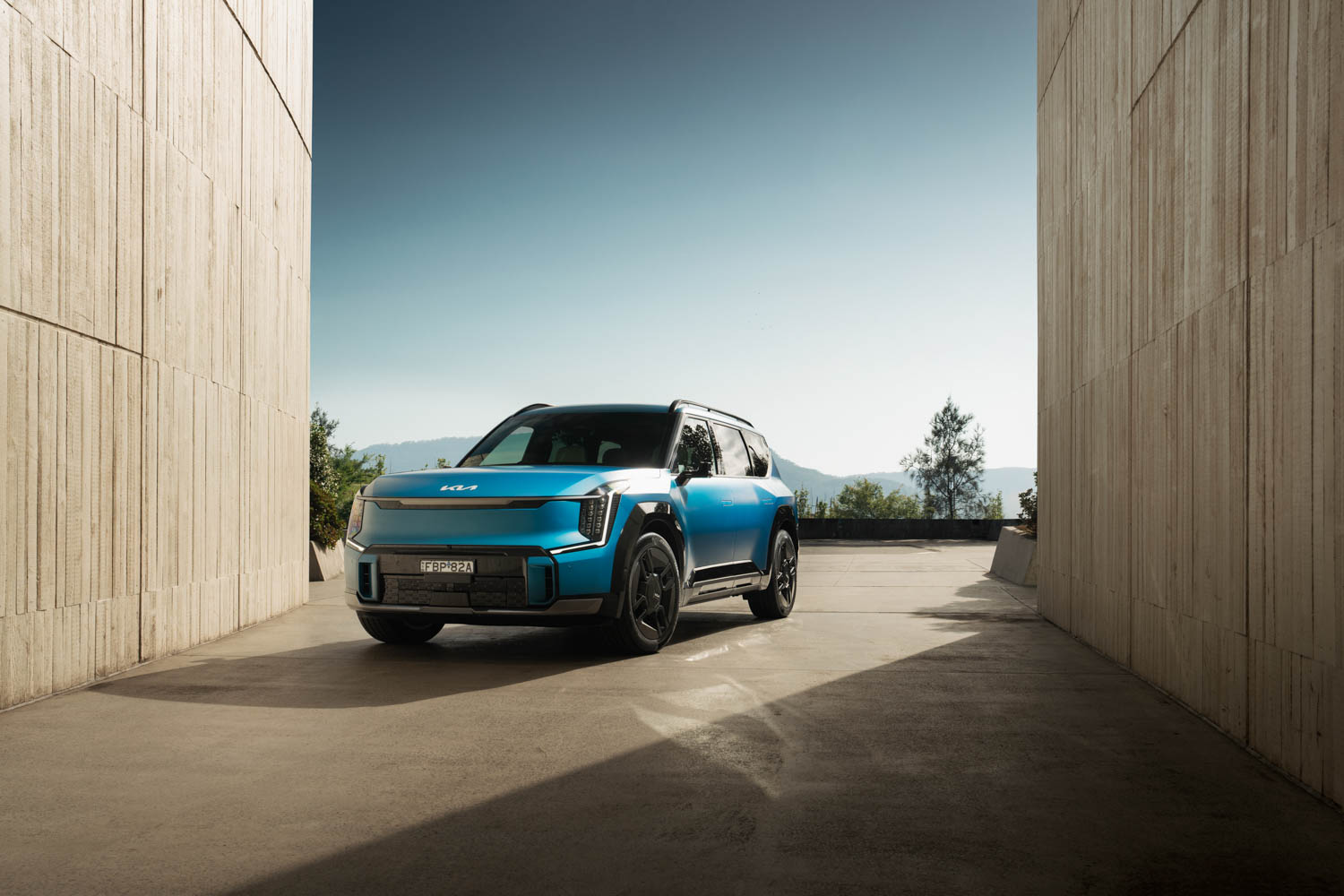These Affordable Amazon Snow Boots Are Suddenly Everywhere — Here’s Why Shoppers Keep Buying Them
Dec 9, 202514 Best EVs In Australia 2024
- Mar 3, 2024
- 0 Comments
323

Whether you like it or not, electric cars will soon be far more common on Australian roads. As governments push for a reduction in carbon emissions, electric car production has been ramped up in an effort to reduce the amount of greenhouse gas being pumped into our atmosphere.
But that’s actually a good thing. Dispel any ideas of electric vehicles being boring: even the smallest EVs are exceptionally fun to drive. Instant torque, linear power delivery, great weight distribution… Electric cars save the planet while still being pretty damn fun – so for those who enjoy speed, you may want to rethink your next car purchase if you were eyeing up a gas-guzzling tarmac-chomping monster of an SUV.
So which are the best electric cars to buy right now in Australia? We’ve carefully curated this list of the best electric car across a range of categories, ensuring everyone is satisfied.
Here’s just a sample of the electric cars featured in this story.
Range: up to 233km
Price: from $71,169 drive away
Test-driven: 31 August 2022
Overseas, there’s plenty of variety when it comes to small electric cars or electric city cars. Australia hasn’t quite caught on to the joys of small EVs just yet, but there is one fun small electric car for sale here: the MINI Electric Hatch.
Australia’s smallest electric car is also one of its most stylish, with its retro aesthetic and dapper interior an antidote to the idea that electric cars are boring.
The MINI Electric Hatch is even better on fuel (chiefly because it doesn’t use any) but also makes 135kW/270Nm – quite a lot for a car that’s almost a metre shorter and 50% more powerful than a Toyota Corolla Hybrid, by way of comparison. Ride and handling are also typically MINI: responsive, snappy and punt-able.
You don’t get oodles of interior space, and its performance and range credentials are hardly segment-leading… But like most MINIs, you’re not really buying it for its practicality per se. That said, its diminutive size is a real selling point. It’s a charming electric car that makes driving fossil-fuel-free a rather fun endeavour.
Check out our full MINI Electric Hatch review to find out more.
Kia EV6
Range: up to 528km
Price: from $72,590 (before on-road costs)
Test-driven: 24 August 2022
The hotly anticipated Kia EV6 has finally launched in Australia. This all-new, all-electric car is a needle shifter for the South Korean manufacturer – fast, cool and good-looking, it’s one hell of a car.
The Kia EV6 makes use of the company’s new E-GMP platform (shared by the Genesis GV60 and Hyundai Ioniq 5 – more on the latter later) which essentially means the floor is flat, resulting in more room inside. Kia says interior space is similar to what you’d find in a medium to large SUV, in what is basically a hatchback.
If that isn’t already enough to whet your appetite, then just take a look at the outside. The EV6 could just be the best-looking electric car on the market. With slick lines, gorgeous alloy wheels and a nice little rear end, this is going to be an electric car you’ll want to be seen in.
That said, passers-by might not get much of a chance to do so since the Kia EV6 isn’t going to be the slouch you might have expected. The top-spec Kia EV6 GT will do 0-100km/h in a blistering 3.5 seconds – that’s faster than an Aston Martin Vantage, a BMW M3 Competition or a Lamborghini Urus.
All models are powered by the same 77.4kWh long-range battery pack, which claims a maximum range of 528km, although in the GT, this is reduced to 420km.
The GT might be fire-breathing (or should that be electricity-breathing?) but Kia has aimed to make the rest of the range as sporty as possible too, especially in terms of the drive. It’s mainly thanks to power being sent to all four wheels, either by a single-motor or a dual-motor system, which certainly helps launch you off from a standing start. It also means the Kia EV6 is keen to hold on in corners, with body roll kept under check.
We reckon the Kia EV6 could just be not only the best looking but the best electric car of 2023, full stop. But let’s not get ahead of ourselves – there are plenty of other cool electric cars on this list.
You don’t get oodles of interior space, and its performance and range credentials are hardly segment-leading… But like most MINIs, you’re not really buying it for its practicality per se. That said, its diminutive size is a real selling point. It’s a charming electric car that makes driving fossil-fuel-free a rather fun endeavour.
Check out our full Kia EV6 GT review to find out more.
Polestar 2
Range: up to 540km
Price: from $59,990
Test-driven: 25 February 2022
If you’re unfamiliar with the name Polestar, it’s an electric car brand spun off from Volvo. Polestar was previously a performance tuner for Volvo vehicles but has since separated to become its own fully-fledged brand, and it’s one that has been generating plenty of excitement.
The Polestar 2 is their first vehicle in Australia. A lithe, high-riding sedan with plenty of Scandinavian charm, it’s also actually made in China – but again, dispel any preconceived notions about Chinese quality. The Polestar 2 looks and feels like a proper luxury car.
There are three models of the Polestar 2 to choose from in Australia: the base model with a standard 470km range and a single motor; a long-range variant of the single motor offering 540km of range or a long-range dual motor that sacrifices range (down to 480km) in favour of performance (capable of a very prompt 4.7 second 0-100km/h time).
The interior is a real highlight. Polestar has opted for a large 11.15-inch display to dominate the central console. This Android Automotive unit can be used to control a variety of functions and you can view several different apps or services at one time, such as Google Maps, Spotify and any notifications that come through to your connected phone. It also offers a digital instrument cluster: a handy feature, as it means you only need to glance down, as opposed to off to the side screen on the side, to view speed, fuel and other essential driver information.
Other specs are relatively standard across the range, so you won’t feel like you’re missing out on much if you only opt for the base model. These features include keyless entry, LED headlights, a rearview camera and a premium audio system, to name a few.
As for the drive, it can only be described as excellent. Great handling, refined, comfortable and plenty quick enough. Polestar has come swinging out the gate with this one.
Check out our full Polestar 2 review to find out more.
Jaguar I-PACE
Range: up to 470km
Price: from $148,800
Test-driven: 13 November 2022
The Jaguar I-PACE is the British brand’s first-ever ground-up electric car, and it’s a pearler. Jaguar was one of the first luxury car brands to realise the importance of electric cars, and five years on from its introduction, the I-PACE remains an exemplar in its field.
A lithe compact crossover, it’s got that perfect mix of sportiness and luxury the Jaguar brand is known for. It boasts a dual-motor, all-wheel drive setup that’s good for 295kW/700Nm of torque and it’ll do 0-100km/h in 4.8 seconds. It’s got a WLTP-rated range of 470km, although we found in real-world driving conditions, it has more like 330kms of range, which is not particularly impressive.
Not only does it have plenty of grunt (great for merging off those challenging British motorway roundabouts), but it handles extremely well, especially for a car of its size and weight (with a kerb weight of 2,133 kg, it’s not exactly an E-Type).
The I-PACE’s interior is a real standout, as is its infotainment and A/C system, which is very easy to use. Acres of supple leather and one of the best centre console layouts in the business make it a truly premium experience.
One of the I-PACE’s coolest features is how you can raise and lower the suspension on demand with a push of a button. This is great for when the roads get a little rougher or if you need to clear a nasty driveway.
Jaguar haven’t updated the I-PACE since it first hit the market in 2018, and some elements of the car reflect that. However, it remains a rather compelling package for someone looking to switch to electric motoring.
RELATED: I Took A 1,000km Road Trip Across The UK In An Electric Car. That Could Never Happen In Australia
MG ZS EV
Range: up to 320km
Price: from $42,990 drive away
Test-driven: 5 October 2022
MG certainly made the right decision to re-enter the Australian car market in 2016. Now a Chinese car brand, the company’s diminutive MG3 is the best-selling light hatchback Down Under thanks to its range of features, great driving experience and incredibly low price.
Similarly, the MG ZS EV has proven to be one of the most popular electric vehicles in Australia. It’s just received a facelift and a significant tech update – yet it remains one of the most affordable EVs in the country.
Just because it’s cheap doesn’t mean it’s nasty, though. Chinese cars used to be pretty awful but the fit and finish on the MG ZS EV is truly impressive. It’s also a pretty good-looking car: we’re a fan of the front end, which features a stylised grille that emphasises its electric bona fides.
Inside, you get an awful lot of kit as standard, including a 10.1-inch multi-function colour touch screen with Apple CarPlay & Android Auto; its own app-based software architecture, known as iSmart, which is backed by Amazon’s AWS cloud-based system; a 12.3-inch digital instrument cluster; plus MG’s Pilot suite of safety technologies.
There are two trim levels but only one battery option is available: a 51kWh unit which is good for 105kW/353Nm. Performance is… Adequate with the ZS EV, but it’ll still out-hustle most cheap SUVs its size. It’s a smooth operator (like most EVs, to be fair): quiet, refined and perfectly suited to city driving.
RELATED: Surprising Car Brand Becomes Unexpected Australian Sales Success
Porsche Taycan
Range: up to 485km (Taycan GTS)
Price: from $158,100 drive away
Test-driven: 18 December 2019
The Stuttgart manufacturer’s first all-electric car is an absolute game-changer and is for those who want something that drives and feels like a proper supercar, but without all the guilt that you’re killing the planet.
Performance figures can get a little confusing, since there are five trim levels to choose from in Australia, each producing a different amount of power, which are as follows:
- Taycan: 240kW/300kW overboost; 280kW with Performance Battery Plus/350kW overboost
- Taycan 4S: 320kW/390kW overboost; 360kW with Performance Battery Plus/420kW overboost
- Taycan GTS: 380kW/440kW overboost
- Taycan Turbo: 460kW/500kW overboost
- Taycan Turbo S: 460kW/560kW overboost
The thing looks like a bloody spaceship and it goes like one, too. Despite having four doors it’s got a 0-100km/h time of between 2.8 and 5.4 seconds, depending on spec level. Confusingly, the top specs are called ‘Turbo’ when there’s no actual turbocharger fitted to these cars. Hashtag just Porsche things.
While Porsche was aiming to mimic the interior of a 911 in the Taycan, it is a futuristic car, so should come as no surprise to find an array of touchscreens inside that cater to driving instruments, infotainment and climate control, as well as functions for controlling other aspects of the car. Your passenger even gets their own screen to control infotainment functions, too.
Smaller than a Panamera but bigger than a 911, the Porsche Taycan has ample space for two adults in the back. There’s also a CrossTurismo station wagon variant that has a more hatchback-like body style with even more space in the rear, making it more of a family car as opposed to a two-seater mid-life-crisis-mobile.
A maximum of 485km of range is available with the Porsche Taycan, but this is only achieved in the Taycan GTS. The base Porsche Taycan doesn’t lag too far behind with a maximum of 434km, but this requires the Performance Battery Plus add-on. The Turbo S gets 405km and the Taycan 4S has 365km as standard, or 414km with the Performance Battery Plus installed. Confusing, we know.
You will likely want to purchase Porsche’s home charging solution to ensure the batteries are recharged as quickly as possible. Porsche claims a full charge can be done in 10.5 hours on a 9.6kW connection. If you can find a fast 270kW DC charger, then you can top up to 80% in just over 30 minutes.
So, with batteries charged, how does it drive? Whichever Taycan you find yourself in, don’t expect to hang around at the lights when you take off. As for cornering, you can be pretty confident going into almost anything, as the Taycan just grips and grips and grips some more. It’s a Porsche after all.
Yes, it’s expensive, but if you have the money, the Porsche Taycan is worth every cent. Read our full review below.
Check out our full Porsche Taycan 4S review to find out more.
Tesla Model 3
Range: up to 602km
Price: from $64,300 drive away
Test-driven: 25 February 2022
Meet Australia’s best-selling electric car. While Tesla wasn’t the first to make an electric car, it has almost single-handedly changed the public perception around EVs and catapulted them into the mainstream. Offering futuristic technologies such as self-driving capabilities, exceptional range and a fast-charging infrastructure network around the globe, there is much for the American carmaker to shout about.
The Tesla Model 3 is the most affordable car in the Tesla lineup, and just so happens to be one of the best electric sedans currently on sale in Australia (although it is beginning to face increasingly stiff competition). There are three models to choose from when you make your order: the base Model 3; Model 3 Long Range and Model 3 Performance.
The base gives you everything you could need from an electric car, while the Long Range increases the size of the battery for, you guessed it, longer range, up to 602km in fact. The Performance sees the top speed increase to 261km/h and a 0-100km/h time of 3.3 seconds. The Performance can be yours for less than $100,000.
Many will be satisfied by the base model’s figures: 491km of range, 225km/h top speed and a 6.1 second 0-100km/h time. It’s also relatively affordably priced: it’s the yardstick by which all other electric cars are measured. No other EV on the market can match Tesla’s overwhelming array of tech, though.
Inside it’s incredibly minimal, with just the now-notorious large iPad-style screen dominating the cabin. You need to use this screen to control virtually all aspects of the car, which could prove cumbersome when driving, but because of the large size, it’s legible and easy to navigate. The driving experience is a pleasant one, although it may take some getting used to.
All in all, the Tesla Model 3 is a great electric car, and if you’re in the market for an affordable slice of luxury to ferry the family around, there’s nothing better. There’s a reason it’s #1.
RELATED: Tesla’s Little-Known Race Cam Feature Could Help Win Over EV Skeptics
BMW iX
Range: up to 630km
Price: from $135,900 drive away
Test-driven: 1 September 2022
The BMW iX signals BMW’s refreshed push into electric power. With a fresh design language (albeit sharing similarities with the X5 SUV) such as frameless doors and more rounded surfaces, it’s certainly an electric car that’s going to turn heads. The polarising kidney grille made notorious by the new M3 / M4 makes an appearance here too. Although in this instance, it’s not actually a grille but a composite panel behind which you’ll find sensors and cameras which are used in driving assistance technologies.
There are four models of BMW iX available in Australia: the standard iX (which is split into three variants, the xDrive 40, xDrive 40 Sport and xDrive 50 Sport) and the more performance-orientated iX M60. Power for the xDrive 40 is rated at 240kW, the xDrive 50 gets 320kW while the M60 maxes out at 455kW. In all iX models, power comes by way of two separate motors, one attached to each axle, which allows it to be constantly analysed and varied depending on driving conditions. BMW claims the iX M60 can do 0-100km/h in 3.8 seconds and has a top speed of 250km/h.
Inside is a far more minimal affair than we’ve come to expect of BMW, with barely a physical button in sight (I know, no buttons in a Beamer!) The majority of the cockpit is dominated by a couple of digital screens, although they are housed within one large curved mount. BMW’s iconic rotary dial is still present, however, which can make navigation a lot more simple. And, despite its large SUV size, you only get five seats, although these do come with a generous amount of headroom.
Charging the BMW iX can be done at a maximum of 200kW, meaning you can charge up to full in around 35 minutes. For owners using the 11kW home wall box, you’ll be waiting 11 hours for a full battery.
The BMW iX is an exciting electric car for sure. Some of you may have preconceived opinions about BMW (or rather, BMW drivers), but they do know how to make a solid, well-performing car, and the iX electric car is certainly no different. We’re keen to see even more electrified models come from the German carmaker in the future.
RELATED: Meet BMW’s Cool Electric Car That Can Change Colour
Hyundai Ioniq 5
Range: up to 451km
Price: from $72,000 before on-road costs
The Hyundai Ioniq 5 went on sale in mid-December 2021 in Australia and sold out instantly. Only a few hundred models were destined for Down Under to begin with, but such was the hype around this car from the South Korean carmaker that those units were snapped up in an instant.
So what makes the Hyundai Ioniq 5 so special? Firstly, just look at the thing. With retro-inspired angles everywhere (we’re arguing the Lancia Delta served as some inspiration) the Ioniq 5 is a truly gorgeous car to look at. It fits firmly into the midsize SUV bracket too and closely resembles the Hyundai Tucson, despite it seeming like it would be more of a hatch, from pictures at least.
Inside Hyundai managed to swamp you with space. The colour scheme aids its light and airy atmosphere, but considering this isn’t a ‘large’ car, it boggles the mind how Hyundai has managed to offer you so much room. There could be a couple of grievances from customers, such as potentially unused space down in front of the armrest, and the armrest itself could have been made larger or extra storage could have been installed. But overall, it’s an incredible place to find yourself sitting. Seats are supportive and comfortable and the front seats can even recline to practically flat levels.
Infotainment is taken care of by way of two 12.3-inch screens for media controls (both Apple CarPlay and Android Auto are supported) and the instrument cluster. Audio experts Bose have provided the eight-speaker sound system, so it should sound as good inside as the car looks from the outside.
There are two models of the Ioniq 5: a single-motor Ioniq 5 2WD and a dual-motor version with AWD. Power output is rated at 160kW and 225kW respectively and range is claimed to be 451km and 430km, respectively. When it comes time to recharge, a standard 240v output will top the Ioniq 5 up to 100% in just over six hours.
However, the Ioniq 5 is also capable of accepting 50kW fast, and 350kW ultra-fast charging methods, which reduces charge times significantly. The 50kW method will get you up to 80% in around an hour, while ultra-fast charging sees that time come down to just under 20 minutes. You will of course need to find such a charging system when on the road.
Speaking of being on the road, the Hyundai Ioniq 5 sure is comfortable to cruise around in. The hefty kerb weight it carries can show up when going around corners at some speed, or even over speed bumps, but in general, there is little to complain about. Plus, it’s incredibly quiet inside, allowing you to further revel in that Bose sound system.
For now, you’ll need to register your interest if you want to be in with the chance of securing yourself an Ioniq 5 (it is available in Australia, it just proved to be so popular that it’s sold out) and while it may be the most expensive car in Hyundai’s entire lineup, it’s without a doubt one of the coolest (let’s not forget the fiery N series). A truly remarkable electric car if ever there was one.
RELATED: Kia’s Next Electric Car Will Be A Dirty Big Off-Roading SUV
Volvo XC40 Recharge
Range: up to 418km
Price: from $73,990
Test-driven: 1 August 2022
Another strong contender for the best-looking electric car in Australia, the compact and stylish Volvo XC40 Recharge. Volvo might be known for boxy station wagons but the XC40 Recharge Pure Electric is something very different.
Volvo is backing electric cars in a big way. The Swedish brand wants all-electric cars to represent 50% of global sales by 2025, and every new Volvo sold since 2019 has some form of electric motor, either as a hybrid or as a full battery electric vehicle (BEV). The XC40 Recharge Pure Electric is the brand’s first fully electric car in Australia.
The Android Automotive infotainment system is a highlight, as is performance: 300kW/660Nm and a 4.9-second sprint to 100km/h. We just like the way it looks – it’s futuristic without being too on the nose.
Being a Volvo it’s safe as houses. Some safety tech highlights include a 360° parking camera, cross-traffic alert with auto-brake and Volvo’s nifty blind spot information system (BLIS), which provides active support when changing lanes. If there is a risk of collision with other vehicles in the adjacent lane, the BLIS can subtly adjust steering. Clever.
RELATED: Volvo’s ‘Boring’ New Station Wagon Is More Interesting Than Any Mercedes
BYD Atto 3
Range: up to 420km
Price: from $48,001 drive away
Chinese carmaker BYD could definitely be one to earmark as its Atto 3 all-electric SUV vies for the title of cheapest electric car in Australia along with the MG ZS EV. Although what you pay for a BYD Atto 3 will be influenced by where you live – it will be cheapest in Tasmania, for example, where you will be able to snap up the Superior (the only grade available) for just under $45,000 drive away.
As we just mentioned, there will be one trim level, but this will be available with two battery options, comprising an entry-level variant and an Extended Range variant. The Extended Range model will cost you an extra $3,000.
Power is provided by a 150kW electric motor, which will see you accelerate to 100km/h in a little over 7 seconds. You will then be able to motor along for up to 320km on a single charge, or up to 420km on a single charge if you opt for the Extended Range model. When the time comes to recharge the Atto 3, you can do so via 7kW AC charging or 80kW DC fast charging using a CSS Type 2 port. This latter option will get you to 80% in 45 minutes.
Standard kit includes a power tailgate, keyless entry, 12.8-inch touchscreen display and wireless phone charging. BYD has also promised an over-the-air update that will bring Apple CarPlay and Android Auto support. There has been a lot of uncertainty about BYD’s warranty and what it actually covers – more to come on that note.
RELATED: American & Japanese Car Makers Are Going To Be Left Behind By China
Audi RS e-tron GT
Range: up to 472km
Price: from $181,700 drive away
Another hotly anticipated electric car to arrive in Australia this year is the Audi e-tron GT, Audi’s entry into the electric performance car market. While it shares the same platform as the aforementioned Porsche Taycan, it’s distinctly an Audi, and has plenty to differentiate itself from its Porsche sibling.
For starters, Audi’s offering is far easier to ascertain, since there are just two models: the e-tron GT and the RS e-tron GT, which we’ve chosen to highlight here. The RS version may not quite compete with Porsche’s top-spec Taycan Turbo S on paper in terms of power, with ‘only’ 440kW to hand (or 475 when overboosted) and a 0-100km/h time of 3.3 seconds… But that’s still plenty fast. We feel this sacrifice, for want of a better word, is worth the cost-saving over the Porsche.
For us (and we imagine many of you) the real selling point for the RS e-tron GT (and its non-RS sibling) is how it looks. This is one of the best-looking Audis to have ever been released in our opinion, and we’ll have no arguments suggesting otherwise. It’s simply gorgeous, offering a blend of futuristic space-age looks with classic, bold and muscular proportions.
Inside continues the standard Audi affair. The German carmaker is a dab hand at designing places you simply don’t want to get out of, and the e-tron GT continues that trend. The driving position is incredible and you’re surrounded by an immersive cockpit comprising digital screens and physical buttons. Everything is laid out ergonomically, so you shouldn’t have any issues making changes to settings whilst keeping your eyes on the road. You can even opt for a vegan leather package that makes your e-tron GT even more eco-friendly.
As for charging, Audi has equipped the e-tron GT with the ability to charge up to 270kW, which will provide around 100km of range from just a 5-minute top-up, or from 5% battery to 80 in a little under 23 minutes. Of course, this is assuming you have access to such a fast charger. For most owners using a standard 11kW box at home, you’ll need to plug it in overnight, as a 5 to 80% charge will take around 9 hours.
How does it drive? Like the Taycan, it’s ridiculously fun, well-composed and ultimately, provides a wholly entertaining driving experience. It accelerates well (obviously) comes to a stop with even more enthusiasm, and can handle itself through corners, which can be somewhat attributed to the sheer weight of the thing. At over 2,300kg, it weighs more than an Audi Q7 SUV.
RELATED: Audi’s New Electric Sports Car Leaves Australian Luxury Buyers With Quite The Predicament
CUPRA Born
Range: up to 511km (TBC)
Price: from $59,990 before on-road costs
For those who don’t know, CUPRA is the offshoot brand of Spanish carmaker SEAT. SEAT is part of the Volkswagen Group, so shares much in common with the likes of VW, Škoda and Audi. CUPRA was originally just SEAT’s performance division (like BMW’s M or Nissan’s Nismo) but it has now become its own brand – and it’s just launched in Australia, ahead of many other markets.
The CUPRA Born will actually be the first Volkswagen Group MEB platform vehicle to arrive Down Under, as it’ll beat the Škoda Enyaq and VW ID.3 to market by a solid 12 months. That means it’ll be our first taste of an affordable EV from the Volkswagen Group – and it’s a pretty exciting taste. Sporty, keenly priced and with decent range, the CUPRA Born is an exceedingly exciting car that’s got the Tesla Model 3 squarely in its sights.
A single e-Boost model will be available, with a 77kWh battery and a rear-mounted motor making 170kW/310Nm and good for a 0-100km/h time of 7 seconds. A Performance Pack will give you larger, stickier tyres and adaptive damping with the cost of a bit of range. 170kW DC fast charging will be supported, allowing you to charge from 5 to 80% in 35 minutes.
The CUPRA Born also just feels pretty special. With one-piece bucket seats as standard, a premium interior that’ll remind you of an Audi and plenty of Spanish charm, it’s a fun little thing. Despite being a high-tech EV, it’s kind of a return to the rear-wheel drive hot hatches of the 80s.
RELATED: CUPRA Is The Most Exciting Car Brand Australia’s Seen For Decades
Kia EV9
DMARGE had the pleasure of spending 48 hours driving the roads of Sydney and the Southern Highlands in this incredibly unique and feature-packed electric SUV.
Admittedly we’re not motoring journalists, rather we’re all about look and feel, and the EV9 looks and feels like nothing on Australian roads. Its boxy design is slightly reminiscent of the cult classic G-Wagen but with a touch of futuristic flair. Kia has carefully designed the car to not overtly look like an EV, unlike most other manufacturers, instead, it’s a subtle blend of both.
Read our full review Kia EV9 review here.
Publisher: Source link







